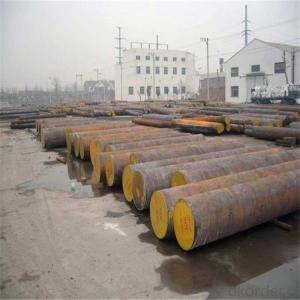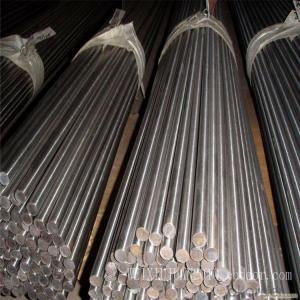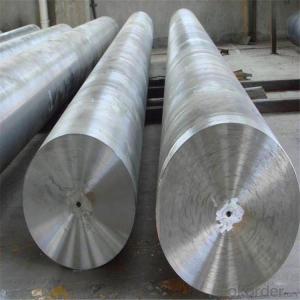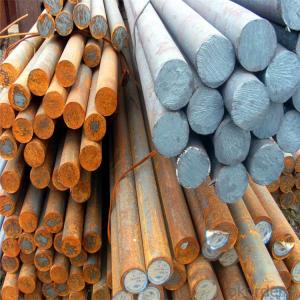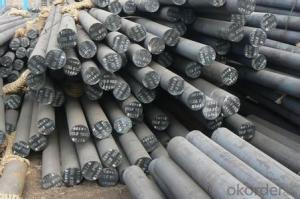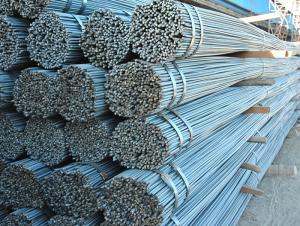MS Mild Steel SAE1020 Hot Rolled Round Bar
- Loading Port:
- Tianjin
- Payment Terms:
- TT OR LC
- Min Order Qty:
- 25 m.t.
- Supply Capability:
- 500000 m.t./month
OKorder Service Pledge
OKorder Financial Service
You Might Also Like
Item specifice
MS Mild Steel SAE1020 Hot Rolled Round Bar
Product Description of MS Mild Steel SAE1020 Hot Rolled Round Bar
1. Steel grade: SAE1020, 20#, C22, S20C
2. Length: 6M-12M
3. Diameter: 16mm-300mm
4. Product range: round bar, flat bar, square bar
5. Technique: Hot rolled, forged, cold drawn
Specification of MS Mild Steel SAE1020 Hot Rolled Round Bar
Material | SAE 1020 | Round bar | Dia(mm) | 16-300mm |
Process | EAF + LF + VD + Forged + Heat Treatment (optional) | Length (mm) | Max 12m | |
Heat treatment | Normalized / Annealed / Quenched / tempered | Flat bar | Thickness(mm) | 8-500mm |
Delivery condition | Hot forged +Rough machined (black surface after Q/T)+ Turned (optional) | Width(mm) | 70-200mm | |
Test | Ultrasonic test according to SEP 1921-84 D/d | Length (mm) | Max 12m |
Chemical Composition of MS Mild Steel SAE1020 Hot Rolled Round Bar
C | Si | Mn | Cr | Ni | Cu |
0.17~0.23 | 0.17~0.37 | 0.35~0.65 | ≤0.25 | ≤0.30 | ≤0.25 |
Photo Show of MS Mild Steel SAE1020 Hot Rolled Round Bar
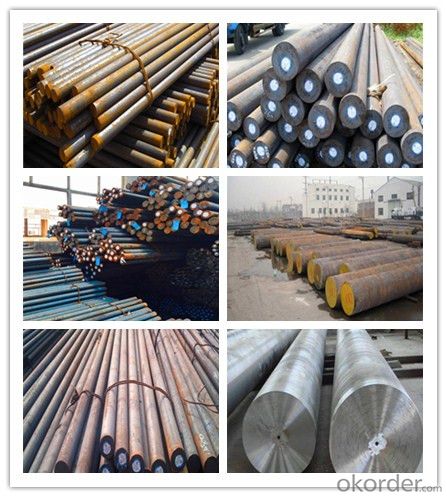
Packing and Delivery:
Packing in bundle package, or as customer's requirements.
Delivery Detail: 45 days after receiving the deposit.
Usage and Applications of MS Mild Steel SAE1020 Hot Rolled Round Bar
1. Steel round bar is used in a large number of architectural and engineering structures. Or it can be used in construction of plants for the production of steel house frames, high-voltage transmission towers, bridges, vehicles, boilers, containers, ships, etc.
2. And we can use this kind of product on the performance of the mechanical parts if the demand is not very high.
3. Some special material steel round bar can be used for main shaft of steamer, hummer shank, with big section and supper force.
Company Information
CNBM International Corporation is the most important trading platform of CNBM group.
Whith its advantages, CNBM International are mainly concentrate on Cement, Glass, Iron and Steel, Ceramics industries and devotes herself for supplying high qulity series of refractories as well as technical consultancies and logistics solutions.


F A Q
1, Your advantages?
professional products inquiry, products knowledge train (for agents), smooth goods delivery, excellent customer solution proposale
2, Test & Certificate?
SGS test is available, customer inspection before shipping is welcome, third party inspection is no problem
3, Factory or Trading Company?
CNBM is a trading company but we have so many protocol factories and CNBM works as a trading department of these factories. Also CNBM is the holding company of many factories.
4, Payment Terms?
30% TT as deposit and 70% before delivery.
Irrevocable L/C at sight.
5, Trading Terms?
EXW, FOB, CIF, FFR, CNF
6, After-sale Service?
CNBM provides the services and support you need for every step of our cooperation. We're the business partner you can trust.
For any problem, please kindly contact us at any your convenient time.
We'll reply you in our first priority within 24 hours.
- Q:What are the safety precautions to be taken while handling steel round bars?
- When handling steel round bars, it is important to follow certain safety precautions to prevent accidents and injuries. Here are some safety measures to be taken: 1. Personal Protective Equipment (PPE): Always wear appropriate PPE, such as safety goggles, gloves, and steel-toe boots, to protect yourself from potential hazards like flying debris, sharp edges, and crushing injuries. 2. Lifting Techniques: Use proper lifting techniques, such as bending your knees and using your leg muscles instead of your back, to avoid strain or back injuries. Do not attempt to lift heavy steel round bars alone; seek assistance or use lifting equipment like cranes or forklifts. 3. Secure Storage: Store steel round bars in a designated area or rack that is stable and secure. Ensure that they are properly stacked and organized to prevent them from falling or rolling onto someone. 4. Handling Tools: Use appropriate tools, such as tongs or lifting hooks, to handle steel round bars. Avoid using your hands or fingers directly to prevent cuts or pinching injuries. 5. Inspection: Before handling steel round bars, inspect them for any defects, sharp edges, or protrusions that may pose a safety risk. If any issues are found, report them to the appropriate personnel and do not use the bars until they are repaired or replaced. 6. Communication: Maintain clear communication with co-workers when handling steel round bars, especially in situations where multiple people are involved. Use hand signals or verbal cues to coordinate movements and avoid accidental collisions. 7. Proper Storage and Transportation: When storing or transporting steel round bars, ensure they are properly secured and adequately supported to prevent shifting, sliding, or falling during movement. 8. Training: Provide appropriate training to all personnel involved in handling steel round bars. This should include proper lifting techniques, the use of PPE, and awareness of potential hazards and safety procedures. By following these safety precautions, you can minimize the risk of accidents and injuries while handling steel round bars. Always prioritize safety to create a secure working environment for yourself and those around you.
- Q:Can steel round bars be used for making stabilizer bars?
- Yes, steel round bars can be used for making stabilizer bars. Steel is a commonly used material in the automotive industry due to its high strength, durability, and resistance to deformation. Stabilizer bars, also known as sway bars, are components in a vehicle's suspension system that help to reduce body roll and improve stability during cornering. These bars are subjected to significant forces and need to be able to withstand the load. Steel round bars provide the necessary strength and stiffness required for stabilizer bars to effectively perform their function. Additionally, steel is readily available and cost-effective, making it a popular choice for manufacturing stabilizer bars in the automotive industry.
- Q:Cold drawn steel wire is a round bar or thread steel in Construction Engineering?
- Cold drawn steel wire belongs to round bar in building engineering, and it is thread steel after coining. But the material of steel is not good. Who knows what material he made?.
- Q:Can steel round bars be used for making decorative items?
- Yes, steel round bars can be used for making decorative items. Steel round bars can be bent, shaped, and welded to create unique and decorative designs. The durability and strength of steel make it a suitable material for creating various decorative items such as sculptures, furniture, and architectural elements.
- Q:What are the different grades of carbon steel round bars for structural applications?
- Carbon steel round bars for structural applications are available in a variety of grades, each with its own unique properties and characteristics. Some of the common grades include: 1. ASTM A36: This is one of the most widely used grades of carbon steel round bars for structural applications. It offers excellent weldability and machinability, making it suitable for a wide range of structural projects. 2. ASTM A572-50: This grade is a high-strength, low-alloy structural steel that offers improved strength-to-weight ratio compared to traditional carbon steel. It is commonly used in construction and structural applications where high strength is required. 3. ASTM A588: This grade is a high-strength, low-alloy structural steel that is primarily used in applications where corrosion resistance is needed. It offers excellent atmospheric corrosion resistance and is often used in outdoor structures such as bridges and buildings. 4. ASTM A709: This grade is a high-strength, low-alloy structural steel that is commonly used in bridge construction. It offers excellent strength, weldability, and toughness, making it suitable for demanding structural applications. 5. ASTM A105: This grade is a low-carbon steel with good strength and impact resistance. It is commonly used in applications where high strength and ductility are required, such as in the construction of heavy equipment and machinery. These are just a few examples of the different grades of carbon steel round bars available for structural applications. The choice of grade depends on factors such as desired strength, weldability, machinability, and corrosion resistance. It is important to consult with a steel supplier or engineer to determine the most appropriate grade for a specific application.
- Q:Can steel round bars be used for making engine parts?
- Absolutely! Engine parts can indeed be made using steel round bars. In fact, steel round bars are commonly employed in the production of engine components. This is primarily due to their remarkable qualities such as exceptional strength, long-lasting nature, and ability to withstand extreme temperatures and corrosion. These bars can be skillfully shaped and resized to fashion a wide array of engine parts including crankshafts, camshafts, connecting rods, and valves. By utilizing steel round bars, the desired mechanical attributes and structural integrity necessary for optimal engine performance and reliability can be ensured. Furthermore, these bars can be subjected to heat treatment and surface treatment techniques to further augment their properties, rendering them incredibly suitable for engine applications.
- Q:How are steel round bars manufactured?
- Steel round bars are typically manufactured through a process known as hot rolling, where a large steel billet is heated and passed through a series of rollers which gradually shape and size it into a round bar. This process ensures the bar's uniformity, strength, and durability, making it suitable for various applications in industries such as construction, manufacturing, and engineering.
- Q:What are the different types of steel round bar surface treatments used in the aerospace industry?
- In the aerospace industry, there are several types of steel round bar surface treatments that are commonly used to enhance the performance and durability of the materials. These treatments are specifically designed to meet the stringent requirements and standards set by the industry. Some of the different types of steel round bar surface treatments used in the aerospace industry include: 1. Passivation: This treatment involves the removal of iron particles and other contaminants from the surface of the steel round bar. It helps to prevent corrosion and improves the overall corrosion resistance properties of the material. 2. Shot Peening: Shot peening is a process that involves bombarding the surface of the steel round bar with small metallic shots. This treatment induces compressive stress on the surface, which enhances the material's fatigue strength and resistance to stress corrosion cracking. 3. Electroplating: Electroplating is a common surface treatment used in the aerospace industry. It involves the deposition of a layer of metallic coating onto the steel round bar through an electrochemical process. This treatment enhances the material's corrosion resistance, wear resistance, and aesthetic appearance. 4. Anodizing: Anodizing is an electrolytic passivation process that is commonly used on aluminum alloys. However, it can also be used on steel round bars. This treatment forms a thick, durable, and corrosion-resistant layer of oxide on the surface, which improves the material's resistance to wear, corrosion, and scratching. 5. Nitriding: Nitriding is a surface hardening treatment that involves the diffusion of nitrogen into the surface of the steel round bar. This treatment improves the material's surface hardness, wear resistance, and fatigue strength. 6. Chemical Conversion Coating: Chemical conversion coating is a treatment that involves the formation of a thin, protective layer on the surface of the steel round bar. This coating enhances the material's corrosion resistance and provides a good base for subsequent paint or coating applications. These are just a few examples of the different types of steel round bar surface treatments used in the aerospace industry. Each treatment offers unique benefits and is selected based on the specific requirements of the application, such as corrosion resistance, wear resistance, fatigue strength, and aesthetic appearance.
- Q:What are the advantages of using free-cutting steel round bars?
- There are several advantages to using free-cutting steel round bars. Firstly, they offer improved machinability, which means they can be easily and efficiently machined into various shapes and sizes without excessive tool wear or power consumption. This leads to increased productivity and reduced manufacturing costs. Additionally, free-cutting steel round bars have excellent chip formation properties, resulting in better surface finish and dimensional accuracy of the machined parts. They also exhibit enhanced surface hardness and wear resistance, making them suitable for applications that require durability and strength. Lastly, these bars are readily available and cost-effective, making them a preferred choice for many industries.
- Q:What is the yield strength of a steel round bar?
- The yield strength of a steel round bar refers to the amount of stress or force that the bar can withstand before it starts to deform or permanently change shape. This is an important property to consider when designing or selecting materials for structural applications. The yield strength of a steel round bar can vary depending on the specific grade or type of steel being used. Common grades of steel such as A36, 1018, and 4140 typically have yield strengths ranging from 36,000 psi (pounds per square inch) to 100,000 psi. However, it is important to note that the yield strength can also be influenced by factors such as heat treatment, manufacturing processes, and the presence of any alloying elements in the steel composition. Therefore, it is always recommended to consult the specific material specifications or conduct proper testing to determine the exact yield strength of a steel round bar in a given application.
1. Manufacturer Overview |
|
|---|---|
| Location | |
| Year Established | |
| Annual Output Value | |
| Main Markets | |
| Company Certifications | |
2. Manufacturer Certificates |
|
|---|---|
| a) Certification Name | |
| Range | |
| Reference | |
| Validity Period | |
3. Manufacturer Capability |
|
|---|---|
| a)Trade Capacity | |
| Nearest Port | |
| Export Percentage | |
| No.of Employees in Trade Department | |
| Language Spoken: | |
| b)Factory Information | |
| Factory Size: | |
| No. of Production Lines | |
| Contract Manufacturing | |
| Product Price Range | |
Send your message to us
MS Mild Steel SAE1020 Hot Rolled Round Bar
- Loading Port:
- Tianjin
- Payment Terms:
- TT OR LC
- Min Order Qty:
- 25 m.t.
- Supply Capability:
- 500000 m.t./month
OKorder Service Pledge
OKorder Financial Service
Similar products
New products
Hot products
Related keywords
